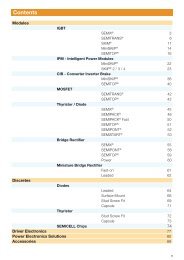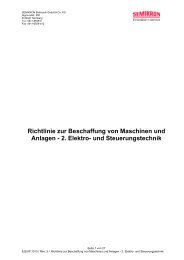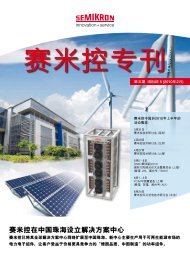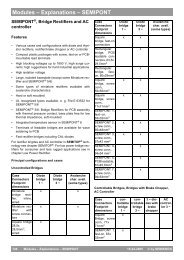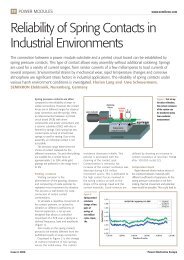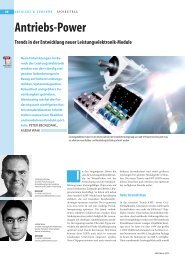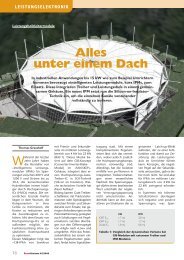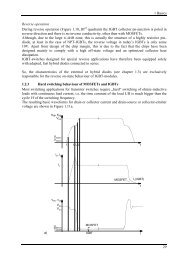Application Note - Semikron
Application Note - Semikron
Application Note - Semikron
Create successful ePaper yourself
Turn your PDF publications into a flip-book with our unique Google optimized e-Paper software.
<strong>Application</strong> <strong>Note</strong> AN-11001<br />
AC terminal as long as T1 is switched on. When T1<br />
switches off, the current commutates to the inner<br />
switches T2/D3; the current now flows from N via T2 and<br />
D3 to AC. T2 stays switched on all the time; as soon as<br />
T1 is switched on, the diode D3 blocks the voltage and<br />
so avoids a short cut of the upper half of the DC-link.<br />
In operating area 4 (Fig. 19) the output current is<br />
negative while the voltage is positive (Fig. 15). The<br />
current commutates back and forth between the inner<br />
switches T3/D2 and the diode D1.<br />
Fig. 19: Commutation path in operating area 4<br />
Fig. 16: Commutation path in operating area 1<br />
DC+<br />
4.<br />
DC+<br />
DC+<br />
VDC/2 VDC/2<br />
N<br />
D2<br />
T2<br />
T3<br />
D3<br />
T1<br />
T4<br />
AC<br />
1.<br />
D1<br />
IAC<br />
D4<br />
DC+<br />
VDC/2 VDC/2<br />
N<br />
D2<br />
T2<br />
T3<br />
D3<br />
T1<br />
T4<br />
AC<br />
D1<br />
IAC<br />
D4<br />
VDC/2 VDC/2<br />
N<br />
DC-<br />
D2<br />
T2<br />
T3<br />
D3<br />
T1<br />
T4<br />
AC<br />
D1<br />
IAC<br />
D4<br />
VDC/2 VDC/2<br />
N<br />
DC-<br />
D2<br />
T2<br />
T3<br />
D3<br />
T1<br />
T4<br />
AC<br />
D1<br />
IAC<br />
D4<br />
DC-<br />
DC-<br />
In operating area 2 (Fig. 17) the output current is still<br />
positive while the voltage is negative (Fig. 11). It<br />
commutates back and forth between the inner switches<br />
T2/D3 and the diode D4.<br />
Fig. 17: Commutation path in operating area 2<br />
DC+<br />
VDC/2 VDC/2<br />
N<br />
DC-<br />
D2<br />
T2<br />
T3<br />
D3<br />
T1<br />
T4<br />
AC<br />
D1<br />
IAC<br />
D4<br />
2.<br />
Fig. 18 shows the conduction paths of operating area 3;<br />
the current commutates between T4 and the inner<br />
switches T3/D2. The current flows from the AC terminal<br />
to the DC-link and, current and voltage are negative (see<br />
Fig. 13). T3 stays switched on permanently; as long as<br />
T4 is switched on as well the diode D2 blocks the voltage<br />
and avoids shorting the negative half of the DC-link.<br />
DC+<br />
VDC/2 VDC/2<br />
N<br />
D2<br />
T2<br />
T3<br />
D3<br />
T1<br />
T4<br />
AC<br />
D1<br />
IAC<br />
D4<br />
3L converter<br />
Module consideration<br />
When a 3L module is designed especially the<br />
commutation paths find consideration: large commutation<br />
paths inherit large stray inductances. When the load<br />
current through a conduction path with large stray<br />
inductance is switched off high voltage overshoots occur.<br />
To avoid a destruction of the semiconductor the voltage<br />
overshoot must stay below its blocking voltage. That can<br />
be reached by either reducing the maximum allowed DClink<br />
voltage and allowing higher overshoots or by<br />
reducing the stray inductances producing less<br />
overshoots.<br />
Of course the aim is to reduce the stray inductance and<br />
allow higher DC-link voltages (that increases the possible<br />
AC output voltage and so the module power).<br />
Setup with standard 2L modules<br />
Theoretically 3L topologies can be set up with already<br />
existing standard 2L modules (Fig. 20 & Fig. 21). The<br />
assembly would require bus bar interconnection of the<br />
modules and would be very scalable.<br />
Fig. 18: Commutation path in operating area 3<br />
DC+<br />
VDC/2 VDC/2<br />
N<br />
D2 T3<br />
3.<br />
D1<br />
T1<br />
AC<br />
IAC<br />
T2 D3<br />
D4<br />
T4<br />
DC+<br />
VDC/2 VDC/2<br />
DC-<br />
DC-<br />
DC-<br />
N<br />
T1<br />
D2 T3<br />
T2 D3<br />
T4<br />
AC<br />
D1<br />
IAC<br />
D4<br />
NPC:<br />
Practically the NPC setup from 2L modules (Fig. 20)<br />
inherits always very long conduction paths, especially for<br />
the commutations across module borders (that gets even<br />
worse for the long commutation paths).<br />
Due to the stray inductance these large commutation<br />
paths produce very high voltage overshoots so that the<br />
shown setups offer no advantages in regard to 2L<br />
designs.<br />
6 / 12 2012-09-03 – Rev04 © by SEMIKRON



